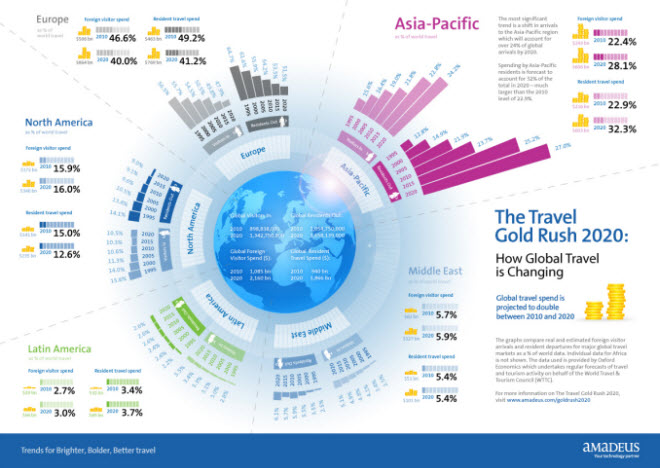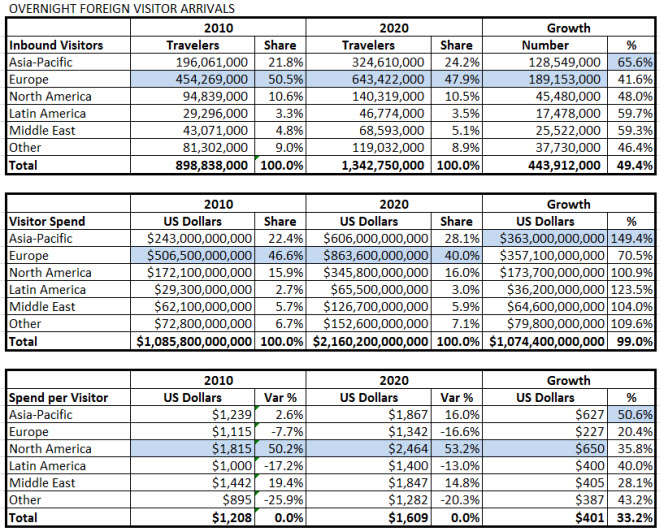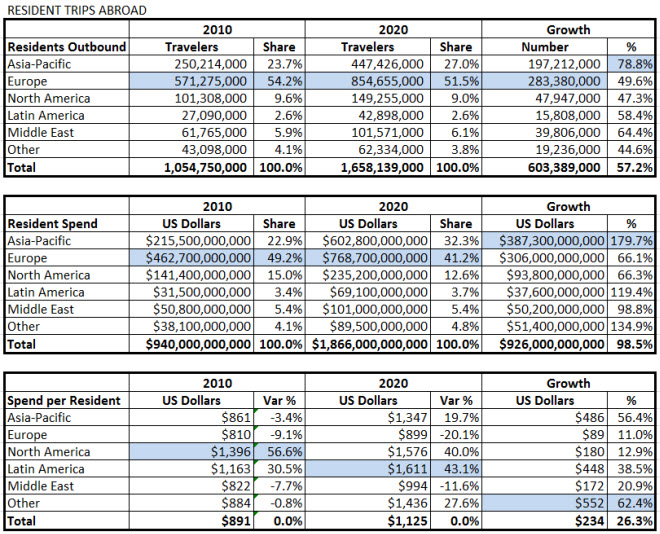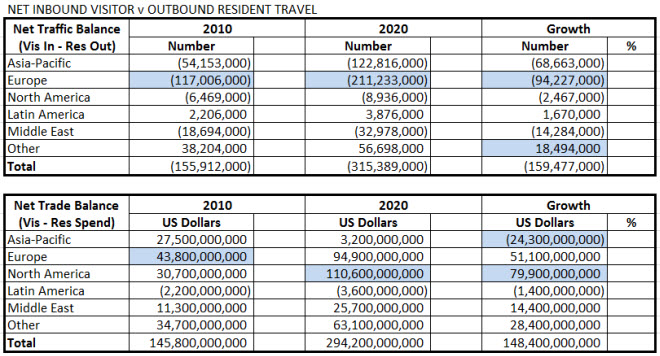Amadeus recently sponsored a research study evaluating the profile of the global travel industry in 2020. The report, titled The Travel Gold Rush 2020, prepared by Oxford Economics, arrived at the conclusions that the greatest trends would be a “dramatic realignment” of travel spend with Asia-Pacific visitor arrivals accounting for 22% of global traffic and Asia-Pacific residents representing 32% of global travel spend in 2020.

Not much has changed in the 160 years since the California Gold Rush. The winners will still need to get there first, and having some good luck wouldn’t hurt either
Photo Credit: ToOliver2 | Flickr
While these statistics are accurate, upon closer examination of the figures, a number of more subtle changes are forecast to occur – many that may be surprising and unexpected for individuals that may have seen the accompanying infographic that depicted comparatively large golden piles of coins and large pink rays of growth emanating from the Asia-Pacific region.
The Asia-Pacific growth projected is indeed impressive, yet the visual impact of the graphics overshadow the digits indicating the percentage share of overnight foreign visitor arrivals, resident trips abroad, and the related travel spend associated with those visitors and residents respectively.
What may be difficult to discern from briefly glancing at the infographic is that Europe will continue to exhibit a dominating share of the 2020 global travel market, with more than half of resident trips abroad originating from Europe and 40% of the foreign visitor spend transacting in Europe.
Taking a closer look at the Travel Gold Rush 2020 Infographic, the great news is that global travel spend is projected to double between 2010 and 2020, but the design does not illustrate the doubling of the travel pie.

A beautiful Infographic does not always tell the full story. In this case, it is difficult to see that Europe will produce 400 million more outbound travelers and receive nearly double the inbound visitors relative to the Asia-Pacific region in 2020.
The study segments its travel projections by three dimensions:
- Direction (Inbound or Outbound)
- Region (Asia-Pacific, Europe, North America, Latin American, Middle East and Other)
- Timeframe (1995, 2000, 2005, 2010 and 2020)
This discussion will focus solely on the 2010 and 2020 figures, with the objective of highlighting trends impacting foreign visitor arrivals and resident trips abroad, plus how the inbound and outbound traffic balances out to identify any big winners and losers.
Welcoming the World
The number of visitors arriving annually into each region are presented below –

While Asia-Pacific will witness a startling percentage increase in visitors, Europe will remain a strong leader in visitor arrivals and travel spend in real numbers.
Despite being projected to lose 2.6 points of global market share, when it comes to foreign visitor arrivals, Europe is still the big winner, with estimated growth exceeding 189 million visitors in the next 10 years. This rate of growth surpasses real growth in the Asia-Pacific region by more than 60 million visitors, although Asia-Pacific will experience the greatest relative visitor growth (65.6%.)
Growth in Europe and Asia will not come to the detriment of other regions which will see growth rates over the ten year period ranging from 46.4% to 59.7%. Europe’s lagging 41% percentage growth statistic should not be considered a problem due to the industry leading real visitor growth.
Asia-Pacific edges out Europe in terms of growth in foreign visitor spend, by a meager $4 Billion on a base of $357 Billion (a touch over 1%.) Based on a ten year forward looking projection, I would call it a horse race. The most startling figure in the study relates to the relative growth of visitor travel spend, with the Asia-Pacific growth rate (1494%) more than doubling Europe’s 70.5% rate of growth.
All other regions of the world are estimated to capture more than 100% increases in foreign traveler spend, wit Latin America running second to Asia-Pacific at 123.5% growth. Again, North America’s 100.9% growth in visitor spend cannot legitimately be deemed disappointing as it exceeds the global average growth rate of 99%.
A second interesting statistic is that North America’s leadership in average spend captured per visitor – 50.2% higher than the global average in 2010, will increase to a 53.2% advantage, or $2,464 per visitor (a $650 increase.)
Asia-Pacific will see average spend per visitor increase nearly as much, $627, a figure more than 50% higher than the 2010 average.
Based on these projections, any destination that is not actively planning to improve its tourism infrastructure runs the risk of missing out on a significant economic windfall. Smart destinations will be able to capitalize on failures of competing countries and regions to appropriately differentiate their destination experience and effectively merchandise their unique value proposition.
Venturing Out of the Neighborhood
Global travel marketers are always interested in tapping into passenger traffic growth, but the real money comes from tapping into those travelers prone to spending more freely.
The annual tally of residents taking trips abroad into each region are presented below –

Asia-Pacific will see the increase in its residents travel spend grow more than the total 2010 travel spend of all regions except Europe.
Europeans in 2010 will take 320 million more resident trips abroad (571 million total) than the second place region, Asia-Pacific whose residents take 250 million total trips. One would not guess from the infographic headlines that the projected increase in European resident trips abroad between 2010 and 2020 will exceed those 250 million Asia-Pacific resident trips in 2010 – that is not a typo – the projected increase in European trips is over 283 million incremental trips abroad.
Asia-Pacific region residents in 2020 don’t catch the Europeans, but a 78.8% increase over 2010 is no cause for shame. Even factoring in the share loss due to the big Asia-Pacific gains, residents of Europe will still generate over 51% of global trips abroad in 2020.
Even with a burst of $387 billion in incremental travel spend (179.7%) from the Asia-Pacific region, Europe comes in with $306 million in growth to retain its leadership position by more than $166 billion over Asia-Pacific. To put the future travel spending increases from Europe and Asia-Pacific in perspective, the $693 billion increase in resident travel spend exceeds the 2010 total combined travel spend from the two regions of $677 billion.
Anyone involved in travel that cannot identify this as an unprecedented opportunity needs to get out of the game. Again, other regions are also growing rapidly, with growth from “Other” regions ($51 billion) slightly edging Middle East growth (50 billion) which reflects a doubling of the 2010 Middle East outbound travel spending.
North America residents have traditionally been the biggest spenders per trip, and that is again the case in 2010. However, they appear poised to lose that position in 2020 to the Latin Americans. Boosted by a 38.5% increase in average spend per trip abroad, the Latin America region easily surpassed North America’s comparatively sluggish 12.9% growth rate.
Perhaps the most unexpected surprise is that average spending per trip will increase by 62.4% from Other regions, moving them from the traditionally lower per-trip spending tier shared with Europe, Asia-Pacific and the Middle East into the North America / Latin America tier. Did not see that one coming…
Asia-Pacific’s 56.4% growth in average spend per resident trip abroad should not be discounted as it generates huge total revenue increases, but it can be argued that this degree of increase was not entirely unanticipated given the advancement of China’s and India’s consumer economies.
Most Destinations Agree: It is Better to Receive than Give
By netting the number resident trips abroad from the number of arriving visitors, including the respective travel spending, one can perform a rough balance of trade calculation. While it may not equate directly to exports and imports, it at least provides some directional indication of whether a region is, on average, sending more travelers or receiving more spend than other regions.

Europe will continue to generate the greatest number of resident departures as compared with its visitor arrivals in 2020
With 1.6 billion trips and approaching $2 trillion in spending, tourism should be able to undeniably stake claim to the title of the world’s largest industry.
So the burning question is, with these significant growth projections, who wins and who loses?
Based Oxford’s predictions, it appears that by some measure, everybody wins. I sincerely hope that these forecasts prove to be true.
From a visitor perspective, in 2010, Europe and Asia-Pacific are the most generous regions in terms of creating outbound resident trips abroad compared to hosting trips by visitors. In the next ten year, each region will become even more generous. In 2020, on a net basis, 333 million more residents will originate trips from Asia-Pacific & Europe than visitors making those areas their travel destination.
Latin American and the Other region currently benefit from receiving more visitors than residents traveling abroad. In 2020, this will exhibit continued growth. Latin America is the only region that spends more abroad than amount spent by visitors to their region. This trait remained consistent in 2010 and 2020.
The big news is for North America, expected to see an $80 Billion increase in travel spending by visitors relative to expenditures by North American residents abroad. As a result in 2020, the surplus will be over $110 Billion.
Extra, Extra – Read All About It!
In summary, Oxford Economics and Amadeus buried the lead: Global Travel Spending Projected to Double Between 2010 and 2020
Highlights include:
- All regions experience dramatic visitor arrival growth; ranging from 40% to 65%
- Europe sees the greatest increase in visitor traffic (189 million incremental visitors), with Asia-Pacific having the largest percentage growth (65%)
- 78% more Asia-Pacific residents will travel abroad in 2020, spending 179% more than 2010
- Expenditures by Asia-Pacific residents traveling abroad will spend $387 billion more on travel than in 2010
- Europeans residents will continue to spend more on travel abroad than any other region, an estimated $768 billion
- Between 2010 and 2020, Europeans will take an incremental 283 million trips abroad, representing a 51.1% of global travel abroad
- In 2020, Latin America will pass North America to spend the highest average amount per trip, $1,611
- North America will receive $110 billion more in travel spending from visitors compared with spending by its residents traveling abroad
This study should provide a much needed dose of optimism for global travel companies beleaguered by two years of recessionary economic challenges. It appears there will be plenty of visitors and money to go around.
I am a big fan of infographics, but it seems a picture is not always worth 1,000 (or in this case, 1,700) words.




